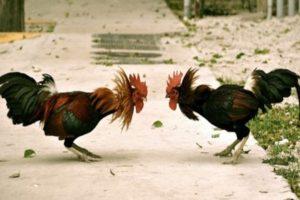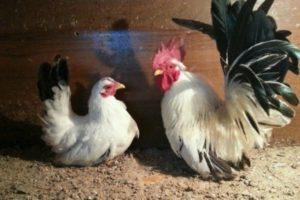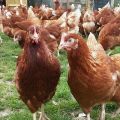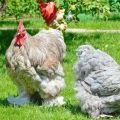Description of Sussex chickens, rules of keeping and feeding
The choice of poultry is influenced by characteristics such as meat taste and egg production. Sussex is a breed of chickens that combines these qualities, and in addition, has a good appearance. This variety is famous not only for its long history, but also for its selection achievements. Sussex has become the basis of a large number of new crosses of chickens, and in order to preserve the purity of the breed in the UK, an amateur club was even created.
History of the origin of the breed
Chickens from Sussex have been known for several centuries, descriptions of birds are found in the records of ancient Rome over 2000 years old. British farmers have been improving the breed's appearance and characteristics over the years. Since 1903, there has been a special club in the country, which is focused on the preservation and improvement of Sussex chickens, which have become the hallmark of the county.
Sussex chickens were bred by crossing the following breeds:
- Dorking;
- Orpington;
- cornish;
- light brama;
- white cochinquin.
Sussex chickens were brought to Russia in 1961, becoming the basis for the domestic breeds of Adler Silver and Pervomaiskaya. The only difference between the birds was their adaptation to the climate of the middle zone.
Thoroughbred Sussex are used primarily for breeding crosses.
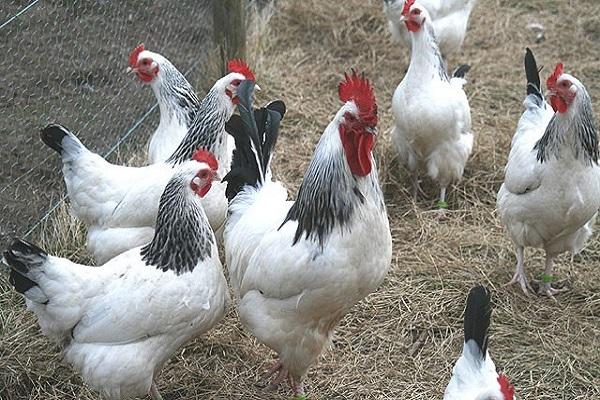
Description and characteristics of Sussex chickens
The Sussex breed has the following features:
- unpretentious content;
- good immunity;
- medium-heavy weight of chickens;
- early onset of oviposition;
- large egg size;
- the average egg production is 195 eggs per year;
- meat and egg breeding direction.
Appearance and color
The appearance of Sussex chickens has certain features:
- the skull is wide and small;
- eyes red or orange, may be speckled;
- red earrings are smooth and rounded;
- underdeveloped scarlet lobes fit snugly to the skull;
- a straight ridge with an uneven surface consists of 4 or 5 teeth;
- light pink beak;
- neck of medium length, strongly feathered;
- wide sternum curved, but smooth;
- tightly pressed wings set high;
- a luxuriantly feathered tail is wide at the base and raised upward;
- muscular paws of a light shade have stripes on the metatarsus;
- fingers are straight.
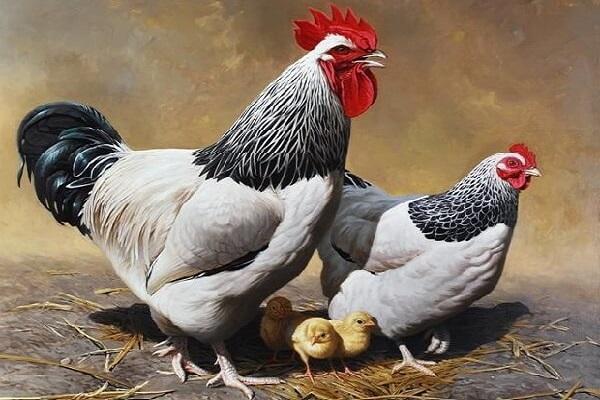
Plumage color options:
- Colombian;
- silver;
- chintz;
- pale yellow;
- red;
- wild (brown).
White, porcelain and royal plumage is considered acceptable, but rare for Sussex..
The nature of the birds
Chickens of the Sussex breed have a calm, balanced disposition, which allows them to keep the species together with other poultry. Adaptability affects the behavior of hens, which become caring mothers. The birds are so loyal that they can also hatch goose or turkey eggs. Chickens show human friendliness and even roosters do not show aggression.

Productivity
Sussex chickens are a versatile breeding type, allowing you to get enough eggs and meat. Chickens by the age of about 3-4 months gain weight up to 1.5 kg. It is not necessary to slaughter poultry at this age, since the taste and texture of the meat do not deteriorate over time. Young hens begin to lay eggs at the age of six months. The productivity of the egg direction is up to 200 pieces per year. The average egg weight is 55-62 g.
Advantages and disadvantages
The Sussex breed has a number of important advantages:
- disease resistance;
- high rate of chick survival;
- low maintenance requirements;
- high productivity of meat and eggs;
- balanced character;
- external appeal;
- quick addiction to living conditions;
- loyalty to humans, birds and animals;
- sex differences in chickens are visible on the 2nd day.
Among the disadvantages of chickens are:
- lack of conscientious breed sellers;
- noisy and loud voice;
- the need for a spacious poultry house and walking area.
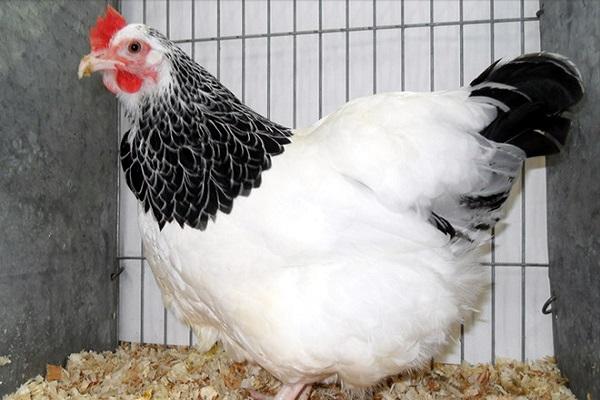
Maintenance in a private household
For a comfortable life, this breed needs:
- spacious poultry house;
- yard for walking;
- constant access to clean water;
- quality feed.
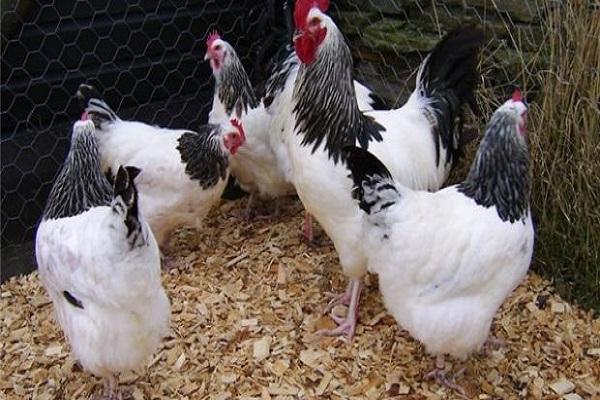
What should be a chicken coop
Sussex chickens are large in size, so a small, cramped house for the breed will not work. On average, the size of the room is selected in the ratio of 1 square meter of floor for 4-5 birds. The building must be equipped to meet the following requirements:
- the temperature in winter should not fall below 10 ° С;
- the presence of ventilation;
- cement floor with fine metal mesh;
- bedding made of natural materials 10-15 cm thick;
- the presence of natural and additional artificial lighting;
- roosts at a height of half a meter at the rate of 0.3 m per bird;
- arrangement of nests measuring 0.3 x 0.4 m in the shaded part of the room, each of which is designed for 3 hens.
Walking yard
The place for walking should be made 2 or 3 times larger than the chicken coop so that the bird does not have to be crowded. The aviary must necessarily have a high fence, a fine mesh is quite enough. Chickens should be able to walk daily, so it is better to equip part of the site with a canopy. Street access for Sussex is also required during the winter.
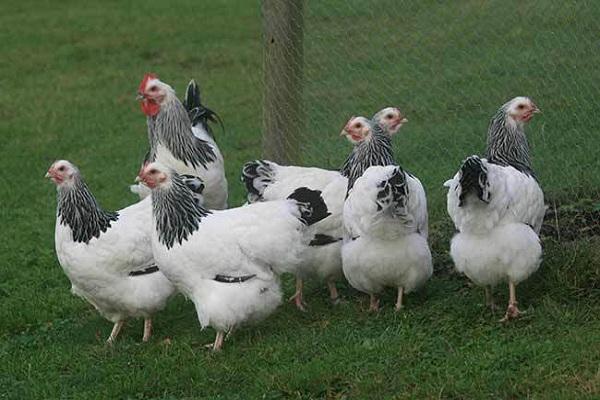
Drinking bowls and feeders
Tanks for food and water should be located both inside the house and outside the house. It is advisable to purchase special drinkers and bird feeders so that water and food do not fall on the floor. Like other chicken breeds, Sussexes are sloppy when feeding, so it is best to use bunker-type containers.
Closed drinkers are well suited for water, as well as devices that supply water automatically.
Planned herd replacement
The lifespan of Sussex hens is 10 years. Gradually, the activity of laying eggs begins to decrease, so the age-old population of chickens needs to be replaced. When growing a breed for meat, slaughter can begin after 70 days of the life of chickens, when the weight reaches one and a half kilograms. Egg production of Sussex chickens peaks at the age of 1 year, so it is preferable to change flocks so that most of the birds are at the stage of maximum productivity.
Seasonal molt
For chickens of this breed, the seasonal change of feathers turns into significant stress.Birds lay fewer eggs and also lose their vitality. An oversight or change in conditions of detention during this period leads to a deterioration in the condition of chickens. During molting, it is recommended to supplement the bird nutrition with a vitamin and mineral complex.
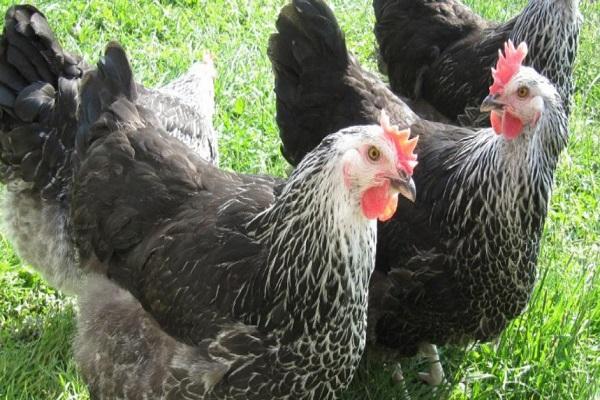
Power Requirements
The diet of poultry must be balanced in such a way that the obtained substances are enough not only for a normal existence, but also for gaining carcass weight. It is recommended to select food for chickens according to the following scheme:
- 60% cereals;
- 30% vegetables;
- 10% greens and dairy products.
For proper digestion, birds also need crushed chalk, charcoal, fine gravel.
Young animals
Newborn chickens require special nutrition, the first days should be given a finely chopped egg and grains. After a few days, you can gradually add compound feed for young birds to the diet. Chickens should contain foods such as:
- millet;
- greenery;
- cottage cheese;
- boiled vegetables;
- fish fat;
- semolina;
- corn (no earlier than 60 days old).

Adults
Raising a large number of Sussex chickens, it is easier to use ready-made feed as food. Poultry food should be based on cereal proteins. To obtain calcium, it is recommended to add ground egg shells, shells of mollusks, bone meal to the feed. In summer, free-range chickens should be fed once a day, in winter or in bad weather - 3 times.
Breeding birds
Sussexes have a well-pronounced hatching instinct, so natural breeding is considered the best option. For full fertilization, it is necessary to collect a herd at the rate of 1 male for 5 females. Eggs can be placed in an incubator, but it is easier to leave with a hen.
After the offspring appear, the layers show concern and do not lose their maternal instinct.
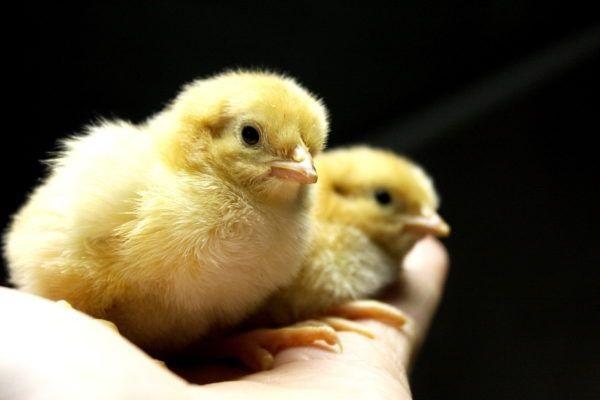
Diseases of the breed
Long-term selection of the breed allowed the Sussex to acquire stable immunity to most poultry diseases. However, the danger can be:
- Coccidiosis. Symptoms include weakness and bloody diarrhea. Treatment involves slaughtering sick individuals and treating the rest of the herd.
- Mycoplasmosis. The disease is caused by a combination of humidity and ammonia in the absence of ventilation in the room. A symptom of the disease is a severe cough. Treatment is carried out by inoculation with a special vaccine.
Parasites such as lice, downy eaters, roundworms and salmonella are also dangerous. To prevent infection, it is necessary to carry out preventive disinfection and disinsection of premises.
